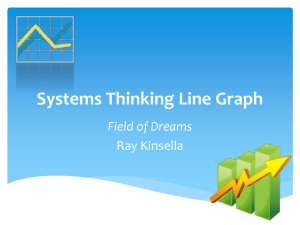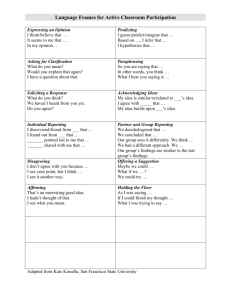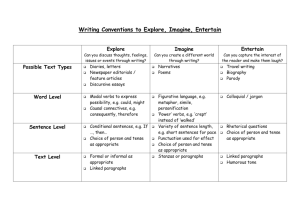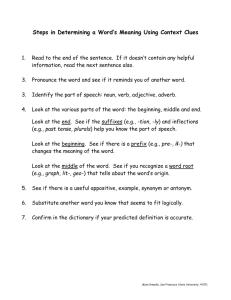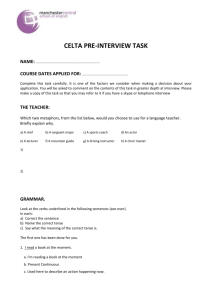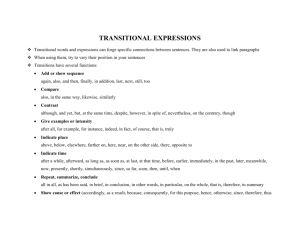English Learners and the Language of Mathematics:
advertisement
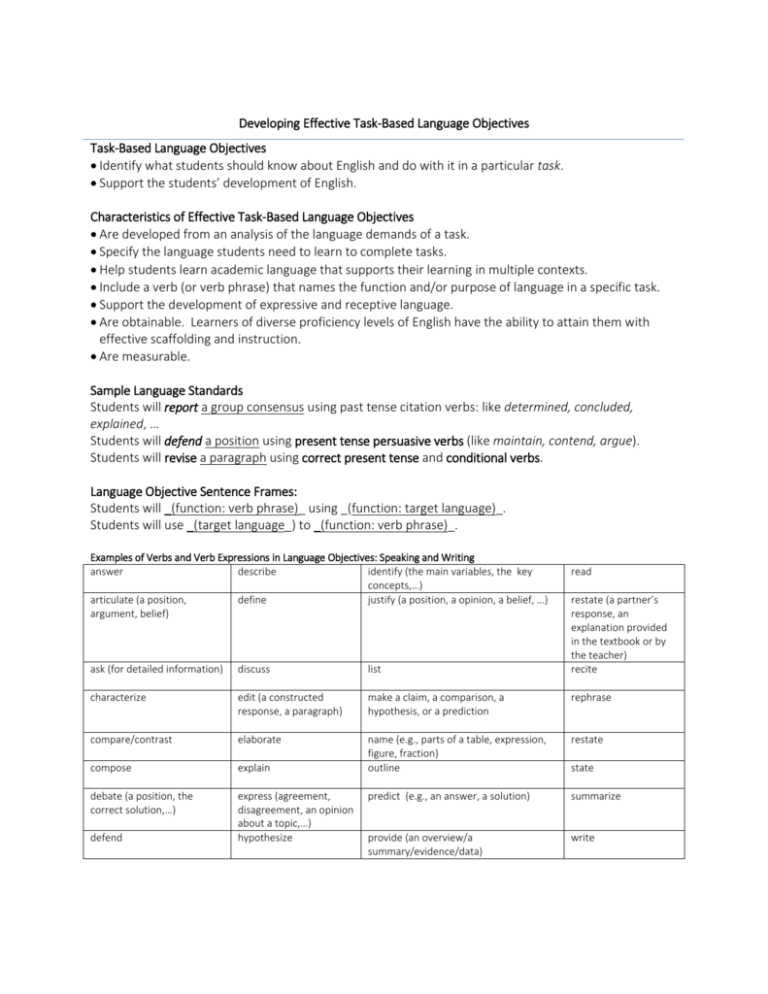
Developing Effective Task-Based Language Objectives Task-Based Language Objectives Identify what students should know about English and do with it in a particular task. Support the students’ development of English. Characteristics of Effective Task-Based Language Objectives Are developed from an analysis of the language demands of a task. Specify the language students need to learn to complete tasks. Help students learn academic language that supports their learning in multiple contexts. Include a verb (or verb phrase) that names the function and/or purpose of language in a specific task. Support the development of expressive and receptive language. Are obtainable. Learners of diverse proficiency levels of English have the ability to attain them with effective scaffolding and instruction. Are measurable. Sample Language Standards Students will report a group consensus using past tense citation verbs: like determined, concluded, explained, … Students will defend a position using present tense persuasive verbs (like maintain, contend, argue). Students will revise a paragraph using correct present tense and conditional verbs. Language Objective Sentence Frames: Students will _(function: verb phrase)_ using _(function: target language)_. Students will use _(target language_) to _(function: verb phrase)_. Examples of Verbs and Verb Expressions in Language Objectives: Speaking and Writing answer describe identify (the main variables, the key concepts,…) articulate (a position, define justify (a position, a opinion, a belief, …) argument, belief) read restate (a partner’s response, an explanation provided in the textbook or by the teacher) recite ask (for detailed information) discuss list characterize edit (a constructed response, a paragraph) make a claim, a comparison, a hypothesis, or a prediction rephrase compare/contrast elaborate restate compose explain name (e.g., parts of a table, expression, figure, fraction) outline debate (a position, the correct solution,…) express (agreement, disagreement, an opinion about a topic,…) hypothesize predict (e.g., an answer, a solution) summarize provide (an overview/a summary/evidence/data) write defend state Key Point: Language objectives are communicated to students clearly. They can be explained orally and in writing and posted in the classroom. They can be referred to before, during and/or after a task. Sample Language Objectives with Verb Phrases and Target Language Features Reading Students will demonstrate their understanding of a text by asking and answering questions about key details in the text using correct question formation and the question words how, what, and why. Students will refer to details and examples in a text when explaining what the text says explicitly, using attributive expressions such as This explanation shows…, explains.., According to _____, ________’s work suggests… and In this passage, … Students will quote accurately from a text when drawing inferences from the text using verbs of inference (infer, suggest, suppose, assume). Students will formulate pre-reading questions using appropriate question structure. Students will make predictions concerning the content of a chapter using the names of specific features of the text (such as headings, captions, illustrations, and tables) and the future tense. Students will articulate the main ideas and details of a reading using the key vocabulary, main idea and details. Students will describe the key points in a text using the following key adjectives: essential, important, significant. Students will explain a concept described in a text using precise adjectives. Students will read text passages containing math words with correct intonation. Students will ask and answer why questions about the concepts presented in a text using the words ___ and ___ that appear in the text and the present tense. Students will describe a word problem that they have read using conditional clauses beginning with the word if. Students will explain the meaning of if clauses in math word problems by splitting the sentence containing the conditional clause into two sentences. Writing Students will write definitions of specific math concepts using complete, well-formed sentences. Students will write definitions of shapes using the pronoun whose. Students will record step-by-step directions for completing a task using transition words like “first,” “second,” “next” and “finally.” Students will write a list of possible solutions to a problem using modal auxiliaries (e.g., could and might). Students will list possible reasons for their conclusions, using verbs for expressing reasons explain, demonstrate, justify and subordinate clauses with because or since. • Students will express an opinion about a concept using present tense verbs for expressing opinions: support, claim, maintain, contend, and believe and complete sentences. • Students will qualify their agreement or disagreement using the verbs agree or disagree and the adverbs somewhat, entirely, absolutely, and completely. • Students will write constructed responses using the words ___, ___, and ____. • Students will replace informal words in their constructed responses with academic words. • Students will summarize a text using present tense verbs and citation verbs (e.g., states, explains, argues). 2 Pages 1-4 are adapted from a CABE presentation by Kate Kinsella. See Kate Kinsella’s web sites for excellent practical resources that promote academic language: www.scoe.org/pub/htdocs/vocabularycomprehension.html, teacher.scholastic.com/products/authors/kinsella.htm, http://pubs.cde.ca.gov/tcsii/prolearningtoolkit/kinsellaindex.aspx • Students will rewrite a constructed response so that it includes smooth transitions between sentences, using transitional expressions and other cohesive devices (e.g., transitional expressions like first, second, and next, demonstrative pronouns- this, these, that, those, and other pronouns like it). • Students will edit drafts of constructed responses for appropriate verb tense, subject-verb agreement, pronoun reference, incomplete sentences and run-on sentences. • Students will write an essay linking opinion and reasons, using transition words, phrases and clauses Listening and Speaking Students will discuss the attributes of specific shapes or objects using specific math vocabulary (___, ___, and ___ ). Students will evaluate the argument and specific claims a classmate makes, including the validity of the reasoning, using the present tense and attributive expressions such as ______ states that…; _____ claims, argues, believes; According to ____; In ___’s opinion…). Students will summarize several key points their teacher has made using the present tense and expressions that are often used to summarize, such as one key point ___ makes is…, another key point ___ makes is …, yet another point ___ makes is.... Students will agree or disagree with answers to specific questions using expressions of agreement and disagreement (I agree/disagree). Students will express an opinion using strong verbs: believe, contend, maintain and expressions for expressing an opinion (It seems to me that…) Students will restate a partner’s response using paraphrasing expressions (so what you are saying is…; in other words, …) Students will discuss a word problem, using passive voice sentences. Students will define the following words ___,___, and ___ using precise adjectives and complete sentences. Students will listen for and point out similarities in their classmates’ ideas using the words similar, identical, and alike and expressions for pointing out similarities (Their ideas were similar/identical/alike; ___’s idea is similar to ____’s. Most of the students agreed that …) Students will report a group consensus using past tense citation verbs (agreed, argued, claimed, concluded, decided, determined, decided) Students will report a group consensus using the words decided/concluded followed by a relative clause (decided/concluded + that + Noun + Verb). Sample Language Targets for Math Language Objectives Vocabulary Academic Vocabulary – words used across content areas (including “precise” adjectives and adverbs). See Academic Word List. Math-Specific Vocabulary— words that do not represent major math concepts that should be taught in the context of math instruction and not through pre-teaching Parts of Words (e.g., perimeter - from Greek peri (around) + metron (measure). Peri is found in other words that are related to “around’ like periphery. The pher in periphery means to carry; The Latin roots of circumference combine circus, the root of circle, with ferre which means, "to carry", thus literally "to carry around". The word is the Latin translation of the Greek word periphereia with the same meaning. Polygon comes from the Greek roots poli (many) and gonus (knees) and, interprets literally as many angled. The relation between knee and angle relates to the flexed position of the knee.http://www.pballew.net/etyindex.html Math Words with Multiple Meanings (e.g., expression, equality, power) Word Families—derivations; words with related parts of speech (e.g., geometry-geometrical) 3 Pages 1-4 are adapted from a CABE presentation by Kate Kinsella. See Kate Kinsella’s web sites for excellent practical resources that promote academic language: www.scoe.org/pub/htdocs/vocabularycomprehension.html, teacher.scholastic.com/products/authors/kinsella.htm, http://pubs.cde.ca.gov/tcsii/prolearningtoolkit/kinsellaindex.aspx Fixed Expressions/Collocations – (e.g., least common denominator; greatest common denominator; negative exponent) Similar Terms, Different Functions; words that are used in different ways, depending on the concept and the construct (e.g., the square - the square root) Grammar Complete Sentences—a basic sentence structure is subject + verb; A complete sentence is a group of words related by meaning that starts with a capital letter and ends with a period, exclamation or question mark, has a subject and a predicate and has complete thoughts. Ellipsis—leaving words out of sentences. In ellipsis, words may be left out of a phrase because native speakers can very easily figure out what the missing words are. - All numbers greater than four = All numbers (that are) greater than four Maria earns six times as much as Peter (…). Jim spent 1 hour and 30 minutes raking the yard in the morning and 1 hour and 45 minutes (…) in the afternoon. How long did he rake altogether? Passive Voice Sentences –making the object of an action into the subject of a sentence. That is, whoever or whatever is performing the action is not the grammatical subject of the sentence. -x is defined to be greater than or equal to zero; -When 15 is added to a number the result is 21. What is the number? Logical Connectors with if, if…then -if and only if -given that -If a is positive then –a is negative. -a + b = c if and only if b + a = c -Given that a = 0, a x b = 0. Articles/Pre-Modifiers -a number…the number -A word that is placed before a word that it modifies (e.g., one number, another number), indefinite adjectives/pronouns, certain, any, some -Five times a number is two more than ten times the number. -One number is ten times another number. If the first number is seven, find the second number. A certain painter paints one house in 8 hours. Comparative Structures -greater than/less than; -n times as much as; -as…as; adj. + er + than -all numbers greater than 4 -Hilda earns six times as much as I do. Hilda earns $40,000 a year. What do I earn? -Mike is two years older than Harry. -Wendy is as old as Jack. Jack is three years older than Frank. Frank is 25. How old is Wendy? Lengthy Noun Phrases—subject and object noun phrases can be long and complex, often with extensive pre-modification and/or post-modification of the main noun. Noun phrases can be expanded and modified almost indefinitely, allowing mathematicians to “pack” a great deal of information into a sentence. Pronouns (I, you, he, she, it, we, they); In pronoun reference, pronouns such as she, he, it, her, him, they, them, their, theirs, hers, his, its, etc. refer to nouns that have been mentioned before. Rachel had 17 toy cars. She gave 11 of them away. How many toy cars does she have now? Other pronouns that students also find challenging include words such as the one(s), that, these, those, and this. Spread your thumb and first finger as far apart as you can. Do this in the air. Don’t use your other hand to help. Trace them on the board. Discourse (This category includes language functions) Forming Interpretations, Explaining, Summarizing, Revising Meaning, Making Predictions, Clarifying, Requesting Clarification (See suggestions on last two pages.) Symbols and Mathematical Notation 4 Pages 1-4 are adapted from a CABE presentation by Kate Kinsella. See Kate Kinsella’s web sites for excellent practical resources that promote academic language: www.scoe.org/pub/htdocs/vocabularycomprehension.html, teacher.scholastic.com/products/authors/kinsella.htm, http://pubs.cde.ca.gov/tcsii/prolearningtoolkit/kinsellaindex.aspx The symbols and notation used to understand math and express math concepts. = > x·y ≠ ~ ≤ < ≥ Activity: Developing Language Objectives Write two language objectives. You may link them to content objectives. Examples Content Objective: Find the area and perimeter of a geometric figure composed of a combination of two or more rectangles, triangles, and/or semicircles with just edges in common. Language Objectives: Use mathematical vocabulary to explain the process for finding the area and perimeter of geometric figures. Write a paragraph comparing the area and perimeter of one geometric figure to another using comparative adjectives (like bigger than, more + adj. + er than ___). 5 Pages 1-4 are adapted from a CABE presentation by Kate Kinsella. See Kate Kinsella’s web sites for excellent practical resources that promote academic language: www.scoe.org/pub/htdocs/vocabularycomprehension.html, teacher.scholastic.com/products/authors/kinsella.htm, http://pubs.cde.ca.gov/tcsii/prolearningtoolkit/kinsellaindex.aspx Verbs Often Used in Language Objective Statements Knowledge: define, describe, identify, know, label, list, match, name, outline, recall, recognize, reproduce, select, state Comprehension: comprehend, convert, defend, distinguish, estimate, explain, extend, generalize, give examples, infer, interpret, paraphrase, predict, rewrite summarize, translate Application: apply, change, compute, construct, demonstrate, discover, manipulate, modify, operate, predict, prepare, produce, relate, show, solve, use Analysis: analyze, break down, compare, contrast, diagram, deconstruct, differentiate, discriminate, distinguish, identify, illustrate, infer, outline, relate, select, separate Synthesis: categorize, combine, compile, compose, create, devise, design, explain, generate, modify, organize, plan, rearrange, reconstruct, relate, reorganize, revise, rewrite, summarize, tell, write Evaluation: appraise, compare, conclude, contrast, criticize, critique, defend, describe, discriminate, evaluate, explain, interpret, justify, relate, summarize, support Discourse (Language Functions): Language Expressions for Discussing Word Problems Expressions for planning and goal setting, tapping prior knowledge, forming interpretations, monitoring understanding, clarifying, etc. Planning and Goal Setting • The reason we are doing this word problem is … • Completing this word problem will help us, because … • We can complete our goal of solving this problem by… Tapping Prior Knowledge • I already know that… • This reminds me of… • The problem relates to the following concepts that I already have studied: … Asking Questions • I wonder why… • What if…? • How come…? • I still have a question about… Analyzing the Language • This word or phrase is key to solving the word problem because… Forming Interpretations • What this means is… • I think this means… • The idea I am getting is… Monitoring • I don’t understand why… • I need to understand why… • I know we are lost here. • I know we are on the right track. • We probably need to … Clarifying • I think X means that… • In other words, we can say that… • To understand better, we need to know more about … • Something that is still not clear is…. • I’m guessing that in this problem, we need to… Explaining • The first step is… • Next,… 6 Pages 1-4 are adapted from a CABE presentation by Kate Kinsella. See Kate Kinsella’s web sites for excellent practical resources that promote academic language: www.scoe.org/pub/htdocs/vocabularycomprehension.html, teacher.scholastic.com/products/authors/kinsella.htm, http://pubs.cde.ca.gov/tcsii/prolearningtoolkit/kinsellaindex.aspx • An essential part of the word problem is…, because • We can ignore these words in the problem, because… • We can take this long sentence apart and make two short sentences: … and … • This pronoun refers to the noun, … Making Predictions • I bet…. • I think… • If ___, then… • I can predict that… • I believe that… • What might happen if… Visualizing • I can picture the steps we need to take to complete the problem. • In my mind, I can see… Making Connections • This reminds me of… • I did a problem that was something like this one when I… • I can relate to this problem because… Adding to Others’ Ideas • I would add that… • Then again, I think that… • I want to expand upon your point that… • A better/different solution might be… • The last part is… • The reason we need to do X is because… • It is important to… • The answer is X because… Revising Meaning • At first I thought …, but then I decided… • My latest thought about this is… • I am getting a different idea about how to solve the problem, because… Requesting Clarification • What do you mean by …? • Can you tell me more about…? • Why did you get that answer? Summarizing • Basically, this problem asks us to… • In a nutshell, in order to solve the problem, all we have to do is… • The key to solving the problem is to… • What I learned is… • The main points we have been discussing are… • To summarize the main points of this discussion, I believe we have said… Reflecting and Relating • So, the most important concepts in this problem are… • A conclusion I am drawing is… • This problem is relevant to me because… Evaluating • I agree/disagree with this, because… • I like …, I don’t like …, because… • I recommend that… • My opinion is …, because • The most important thing we need to remember about completing this type of word problem is… 7 Pages 1-4 are adapted from a CABE presentation by Kate Kinsella. See Kate Kinsella’s web sites for excellent practical resources that promote academic language: www.scoe.org/pub/htdocs/vocabularycomprehension.html, teacher.scholastic.com/products/authors/kinsella.htm, http://pubs.cde.ca.gov/tcsii/prolearningtoolkit/kinsellaindex.aspx

